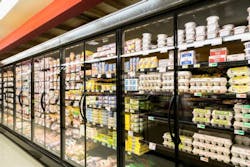When it comes to refrigeration retrofits and/or remodels, supermarket operators have an ever-increasing variety of options from which to choose. One of the primary considerations impacting this decision is the choice of refrigerant — which often dictates the type of architecture and servicing requirements while impacting the cost of system ownership.
Refrigerant selection is also critical to the extent that it must align with an operator’s sustainability goals or help them meet regulatory mandates. A refrigerant’s environmental sustainability is determined largely by its greenhouse gas emissions, which are measured by their ozone depletion potential (ODP) and global warming potential (GWP). Today, operators have an expanding variety of emerging lower-GWP refrigerant alternatives to help them achieve a full spectrum of sustainability goals.
System selection criteria
The decision to retrofit or remodel a refrigeration system must be made with a long-term perspective. Many supermarkets benefit from 20 to 30 years of service from their refrigeration systems and operators expect an extended lifespan from their upgrade investment. But today’s market is much more dynamic than it was when these systems may have originally been installed, so planning for the next two decades of operation is more difficult.
Global, federal and state regulations are phasing down the use of high-GWP refrigerants and nearly phasing out those with ozone depletion potential. At the same time, aggressive corporate sustainability objectives are driving more companies to re-evaluate the viability of their refrigeration systems. Regardless of where you sit along the sustainability continuum, system and refrigerant selection should be guided by the Six S’s of evaluation criteria:
- Simple - to own and operate
- Serviceable - aligns with maintenance and operations capabilities
- Secure - provides safe operation and data security
- Stable - delivers reliable, dependable performance
- Smart - is equipped with electronic controls and connectivity to provide operational data and insights
- Sustainable - from financial, technical and environmental perspectives.
Available Low GWP Refrigerants
Over the past decade, alternative refrigerants have emerged that offer varying degrees of GWP reduction. But among those readily available options that are considered both safe and approved for use, several have emerged which represent distinct approaches to sustainability: low-, lower- and lowest-GWP.
Note: GWP ratings reported herein are from the Fourth Assessment Report (AR4) of the United Nations Intergovernmental Panel on Climate Change (IPCC).
R-448/449A (low-GWP option) — Designed as a substitute for R-404A, R-448A offers a 65% reduction in GWP (1,387 GWP compared to 3,922 GWP). Classified as an A1, R-448A is suitable for centralized direct expansion (DX) retrofits and new distributed systems but is not to be used as a drop-in replacement.
R-513A (lower-GWP option) — R-513A delivers a 56% reduction in GWP (631 GWP vs. 1,430 GWP). This proven low-pressure A1, zero glide refrigerant was designed as a substitute for R-134a and is today being leveraged more frequently in new distributed systems such as scroll booster (see below). It is also not intended to be a drop-in replacement for R-134a.
A2L and A3 (lower- to lowest-GWP) — mildly flammable A2L and flammable A3 (aka R-290 or propane) refrigerants are primarily used in self-contained systems and offer lower- to lowest-GWP reductions, respectively. In the U.S., the creation of safety codes and standards governing their use in commercial refrigeration is currently underway. Until those standards take effect, using A2Ls and A3s may require the approval of local authorities having jurisdiction (AHJ). Today, R-290 (aka propane) is primarily only used in factory-sealed, self-contained systems with very small refrigerant charges of 150g or less.
While A2Ls are currently not allowed in commercial refrigeration applications, Emerson is already qualifying equipment for the use of A2Ls to achieve future regulatory readiness. In some cases, this will allow for end users to install R-448A-based equipment today and then transition to an A2L when needed to comply with future regulations.
CO2 aka R-744 (lowest-GWP option) — Used only in systems designed to handle its unique properties, R-744 is a natural refrigerant with a GWP of 1. Its high-pressure, low critical point (87.8 °F) and high triple point (-69.8 °F) introduce system complexities that require operators to have access to trained CO2 technicians. For these reasons, CO2 refrigeration can have a higher total cost of ownership (TCO) than other alternatives. Even so, systems such as CO2 transcritical boosters have seen increased global adoption over the past two decades.

